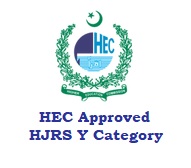The urban expansion and its effect on temperature trends of Faisalabad city, Pakistan
DOI:
https://doi.org/10.47264/idea.nasij/5.1.3Keywords:
Temperature variation, Environmental change, Urban growth, Climate change, Sustainable development, Urbanisation, Environmental problems, Urban planningAbstract
Rapid urbanisation on the global stage is a source of worry over its environmental impacts as far as local climate patterns are concerned. This research analyses the effects of urbanisation indices on local temperature anomalies in Faisalabad, Pakistan, from 1972 to 2022. Trends of mean, maximum, and lowest temperature, urban population, built-up area, the number of factories, and the number of automobiles were analysed in the data of five decades. The plot shows that the warming trend recorded from Faisalabad’s temperature data is evident from an increase in both mean maximum and minimum temperature and the increase in mean temperature by 2°C. The city underwent rapid urbanisation during this period, which resulted in an increased urban population six times, while the extent of built-up areas was extended four times, and industrial and vehicular activities also increased considerably. This provides a statistically excellent correlation between years and temperature measures, yielding coefficients as shown (R2 = 0.9615, 0.9931, and 0.9839), which indicate that the period under study has a solid relationship with these temperature patterns. The research underscores the significant climatic impacts of urbanisation and calls for environmentally responsible urban planning, suggesting global solutions to tackle urban climate change and sustainable development.
References
Arshad, A., Zhang, W., Zaman, M. A., Dilawar, A., & Sajid, Z. (2019). Monitoring the impacts of spatio-temporal land-use changes on the regional climate of the city of Faisalabad, Pakistan. Annals of GIS, 25(1), 57–70. https://doi.org/10.1080/19475683.2018.1543205
Choi, Y. G., Jung, H. S., Nam, K. Y., & Kwon, W. T. (2003). Adjusting urban bias in the regional mean surface temperature series of South Korea, 1968-99. International Journal of Climatology, 23(5), 577–591. https://doi.org/10.1002/joc.881
Chung, U., Choi, J., and Yun, J. I. (2004). Urbanization effect on the observed change in mean monthly temperatures between 1951-1980 and 1971-2000 in Korea. Climatic Change, 66(1-2), 127–136. https://doi.org/10.1023/B:CLIM.0000043136.58100.ce
Duhan, D., Pandey, A., Gahalaut, K. P. S., & Pandey, R. P. (2013). Spatial and temporal variability in maximum, minimum and mean air temperatures at Madhya Pradesh in central India. Comptes Rendus Geoscience, 345(1), 3–21. https://doi.org/10.1016/j.crte.2012.10.016
Farooqi, Z. U. R., Sabir, M., Latif, J., Aslam, Z., Ahmad, H. R., Ahmad, I., ... & Ili?, P. (2020). Assessment of noise pollution and its effects on human health in the industrial hub of Pakistan. Environmental Science and Pollution Research, 27, 2819–2828. https://doi.org/10.1007/s11356-019-07105-7
Fujibe, F., (2009). Detection of urban warming in recent temperature trends in Japan. International Journal of Climatology, 29(12), 1811–1822. https://doi.org/10.1002/joc.1822
Grover, A., & Singh, R. B. (2020). Urban microclimates. Urban health and wellbeing: Indian Case Studies, 151–177. https://doi.org/10.1007/978-981-13-6671-0
Houser, M. (2018). Who framed climate change? Identifying the how and why of Iowa corn farmers’ framing of climate change. Sociologia Ruralis, 58(1), 40–62. https://doi.org/10.1111/soru.12136
Jeganathan, A., & Andimuthu, R., (2013). Temperature trends of Chennai city, India. Theoretical and Applied Climatology, 111(3-4), 417–425. https://doi.org/10.1007/s00704-012-0646-6
Kabisch, N., Frantzeskaki, N., Pauleit, S., Naumann, S., Davis, M., Artmann, M., ... & Bonn, A. (2016). Nature-based solutions to climate change mitigation and adaptation in urban areas: perspectives on indicators, knowledge gaps, barriers, and opportunities for action. Ecology and Society, 21(2). https://doi.org/10.5751/ES-08373-210239
Kirshen, P., Ruth, M., & Anderson, W. (2008). Interdependencies of urban climate change impacts and adaptation strategies: a case study of metropolitan Boston USA. Climatic Change, 86(1-2), 105–122. https://doi.org/10.1007/s10584-007-9252-5
Kishtawal, C. M., Niyogi, D., Tewari, M., Pielke Sr, R. A., & Shepherd, J. M. (2010). Urbanization signature in the observed heavy rainfall climatology over India. International Journal of Climatology, 30(13), 1908–1916. https://doi.org/10.1002/joc.2044
Martilli, A., Krayenhoff, E. S., & Nazarian, N. (2020). Is the urban heat island intensity relevant for heat mitigation studies? Urban Climate, 31, 100541. https://doi.org/10.1016/j.uclim.2019.100541
Mumtaz, F., Li, J., Liu, Q., Tariq, A., Arshad, A., Dong, Y., ... & Liu, C. (2023). Impacts of green fraction changes on surface temperature and carbon emissions: comparison under forestation and urbanization reshaping scenarios. Remote Sensing, 15(3), 859. https://doi.org/10.3390/rs15030859
Ooka, R. (2007). Recent development of assessment tools for urban climate and heat-island investigation especially based on experiences in Japan. International Journal of Climatology, 27(14), 1919–1930. https://doi.org/10.1002/joc.1630
Opoko, A. P., & Oluwatayo, A. (2014). Trends in urbanization: implication for planning and low-income housing delivery in Lagos, Nigeria. Architecture Research, 4(1A), 15–26. https://doi.org/10.5923/s.arch.201401.03
Parker, D. E. (2010). Urban heat island effects on estimates of observed climate change. Wiley Interdisciplinary Reviews: Climate Change, 1(1), 123–133. https://doi.org/10.1002/wcc.21
Parveen, N., Ghaffar, A., Nasar-u-Minallah, M., & Ali, M. (2019). Analytical study on urban expansion using the spatial and temporal dynamics of land use change in Faisalabad city, Pakistan. International Journal of Economic and Environmental Geology, 10(3), 102–108. https://doi.org/10.46660/ojs.v10i3.318
Rahman, K. S., & Thelen, K. (2019). The rise of the platform business model and the transformation of twenty-first-century capitalism. Politics & Society, 47(2), 177–204. https://doi.org/10.1177/0032329219838932
Ravanelli, R., Nascetti, A., Cirigliano, R. V., Di Rico, C., Leuzzi, G., Monti, P., & Crespi, M. (2018). Monitoring the impact of land cover change on surface urban heat island through Google Earth Engine: Proposal of a global methodology, first applications, and problems. Remote Sensing, 10(9), 1488. https://doi.org/10.3390/rs10091488
Roy, S. S., & Balling, R. C. (2005). Analysis of trends in maximum and minimum temperature, diurnal temperature range, and cloud cover over India. Geophysical Research Letters, 32(12), L12702. https://doi.org/10.1029/2004GL022201
Sajjad, S. H., Hussain, B., Khan, M. A., Raza, A., Zaman, B., & Ahmed, I., (2009a). On rising temperature trends of Karachi in Pakistan. Climatic Change, 96(4), 539–547. https://doi.org/10.1007/s10584-009-9598-y
Sajjad, S. H., Shirazi, S. A., Ahmed Khan, M., & Raza, A., (2009b). Urbanization effects on temperature trends of Lahore during 1950-2007. International Journal of Climate Change Strategies and Management, 1(3), 274–281. https://doi.org/10.1108/17568690910977483
Tariq, A., & Shu, H. (2020). CA-Markov chain analysis of seasonal land surface temperature and land use land cover change using optical multi-temporal satellite data of Faisalabad, Pakistan. Remote Sensing, 12(20), 3402. https://doi.org/10.3390/rs12203402
Wu, H., Jin, S., & Yue, W. (2022). Pricing policy for a dynamic spectrum allocation scheme with batch requests and impatient packets in cognitive radio networks. J. Sys. Sci. Sys. Eng. 31(2), 133–149. https://doi.org/10.1007/s11518-022-5521-0
Yang, Y., Liu, L., Zhang, P., Wu, F., Wang, Y., Xu, C., & Kuzyakov, Y. (2023). Large-scale ecosystem carbon stocks and their driving factors across Loess Plateau. Carbon Neutral, 2(1), 5. https://doi.org/10.1007/s43979-023-00044-w
Zalasiewicz, J., & Williams, M. (2012). The goldilocks planet: The 4-billion-year story of Earth’s climate. Oxford University Press. https://doi.org/10.1093/oso/9780199593576.001.0001
Downloads
Published
Issue
Section
License
Copyright (c) 2024 Muhammad Zaib Arshad, Zafar Iqbal, M. Satish Kumar

This work is licensed under a Creative Commons Attribution 4.0 International License.
Please click here for details about the Licensing and Copyright policies of NASIJ.








